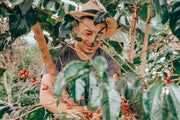How Coffee Cultures Are Evolving Around the World: From Italy to Japan

Coffee is more than just a beverage—it’s a cultural cornerstone in many parts of the world. From the quick espresso shots in Italy to Japan's ceremonial approach to coffee, each country has its own way of enjoying this beloved drink. Yet, in recent years, coffee cultures are evolving, blending tradition with new trends in specialty coffee. Today we wanted to explore how the coffee experience is changing in different parts of the world and what that means for coffee lovers everywhere.
Italy – The Home of Espresso, Slowly Evolving
Italy is synonymous with espresso. For many Italians, drinking espresso is a ritual. It’s common to take multiple shots throughout the day, often consumed quickly while standing at a café bar. Espresso culture is about simplicity, efficiency, and tradition. But even in Italy, change is brewing.

While espresso remains king, the rise of specialty coffee is beginning to make waves. Third-wave coffee shops are slowly popping up in cities like Milan and Rome, where customers are introduced to alternative brewing methods like pour-over and Chemex. These cafés offer a different experience—one that focuses on the quality and origin of the beans, as well as ethical sourcing and sustainability.
However, this shift is gradual. Most Italians still prefer their traditional espresso-based drinks like cappuccinos and macchiatos. But with more young Italians exploring specialty coffee, the question remains: Will Italy fully embrace these new trends, or will the classic espresso always dominate?
Japan – A Quiet Coffee Revolution
Japan’s coffee history is deeply rooted in kissaten, traditional coffee houses that have been around since the early 1900s. These establishments focus on slow, deliberate brewing and an atmosphere that encourages quiet contemplation. However, Japan is now experiencing a coffee revolution, led by specialty coffee and third-wave cafés.
Today, you’ll find specialty coffee shops in cities like Tokyo, Kyoto, and Osaka that offer a range of brewing methods like siphon, pour-over, and Aeropress. The Japanese approach to coffee is meticulous, with an emphasis on quality and precision. Customers can often watch as their coffee is slowly brewed, turning the process into a performance.
In 2023, Japan's coffee market revenue was estimated at $34.19 billion, and a large portion of this comes from specialty coffee.
The U.S. – From Diner Coffee to Third-Wave Sophistication
The United States has long had a deep relationship with coffee. From the humble beginnings of diner coffee to the explosion of chain cafés like Starbucks, coffee has always been about convenience and speed in America. But in recent years, the U.S. has been at the forefront of the third-wave coffee movement.
Third-wave coffee emphasizes transparency, ethical sourcing, and an appreciation for the craft of coffee-making. Specialty cafés across the U.S. now offer everything from nitro cold brew to pour-over, with an emphasis on single-origin beans. This shift in coffee culture is evident in major cities like Portland, New York, and San Francisco, where local roasters play a crucial role.
According to the National Coffee Association, 60% of Americans now opt for specialty coffee, reflecting a major shift in preferences.
Scandinavia – A Love Affair with Filter Coffee
Scandinavians are among the world’s most passionate coffee consumers. In countries like Norway, Sweden, and Finland, filter coffee is the drink of choice, with consumption levels among the highest globally. Finland, for example, consistently ranks as the top coffee-consuming nation per capita.

Yet even in this filter coffee stronghold, the third-wave coffee movement is gaining ground. Specialty coffee shops are emerging in major cities like Stockholm and Oslo, introducing locals to new brewing methods and single-origin beans. Scandinavian coffee culture is also strongly linked to sustainability, with a focus on eco-friendly coffee packaging and ethical sourcing.
A 2022 report from the European Coffee Federation highlights the growing popularity of specialty coffee in Scandinavia, despite the region’s long-standing love affair with traditional filter brews.
Australia – The Birthplace of the Flat White
Australia is known for its café culture, which is fiercely competitive. Australians take their coffee seriously, and the flat white—an iconic small, velvety latte—was born out of this coffee dedication.
But even in a country already obsessed with coffee, specialty coffee is taking the scene by storm.
In recent years, many Australian cafés have shifted toward roasting their own beans, with a strong focus on single-origin coffees. These cafés now offer a range of brewing methods, including Chemex, cold drip, and siphon. According to IBISWorld, the café industry in Australia is expected to grow by 2.4% annually, with specialty coffee driving much of this demand
Coffee Cultures Blending Tradition with Innovation
Across the world, coffee cultures are evolving in response to globalization, environmental concerns, and consumer demand for quality. Whether it’s Italy’s slow shift toward specialty coffee or Japan’s meticulous third-wave cafés, the world of coffee is more dynamic than ever.
As new brewing methods and ethical sourcing practices take hold, coffee lovers have the opportunity to explore flavors and experiences that reflect both tradition and innovation. So next time you sip your espresso, flat white, or pour-over, remember—you’re not just drinking coffee, you’re part of a global evolution in how we enjoy this beloved beverage.





